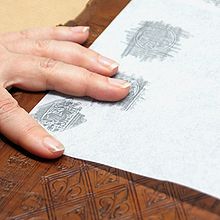Brass rubbing

The Brass rubbing is a graphical imaging technique, as in the case of a poor imitation of an object by abrasion, is usually transmitted with chalk or pencil on paper down an inclined surface relief. It enables detailed reproduction and documentation of engraved metal plates or inscriptions as well as various other surface structures on paper. The technique, which is easy to learn, is particularly widespread in England . The same technique is used to rub through the cover .
A well-known children's game is e.g. B. The depiction of coinage through frottage , especially in the USA, frottage of famous gravestones is a popular tourist souvenir .
Monumental brasses
Towards the end of the High Middle Ages , Europe's wealthy classes began to erect elaborate tombs and epitaphs in churches and cathedrals. While such monuments were previously reserved for the high nobility or high clergy, members of the lower nobility , wealthy citizens and priests can now also be immortalized in this way. In addition to figurative representations of the deceased, there are also coats of arms , ornaments or church implements on the memorial stones. On the continent in particular, most of these monuments were carved out of stone in full or semi-sculptural form. However, there are also numerous engraved metal plates in the churches of Europe. A particularly large number of examples have survived in England (around 8,000, including around 4,000 with figurative representations), while the formerly rich French inventory was almost completely destroyed by the wars of religion in the 16th century and the French Revolution . In Germany notable examples have survived in northern Germany and Saxony, for example in the domes of Meißen and Freiberg . However, engraved grave monuments were far rarer in the German-speaking area than in Western Europe. Such bream - which is where the name comes from in connection with "rubbing" - were cheaper than carving and easier to transport. The representations were engraved or etched into the metal in the manner of copper engravings , and the plates were then polished.
At the end of the 18th and early 19th centuries in England, in the course of the rediscovery of the Middle Ages, attention was also drawn to the - often very decorative - engraved grave monuments. Abrasions were particularly valued as decorative items in the Victorian era. Because of the mentioned resemblance of these objects to printing plates, the engravings were sometimes filled with color and thus prints were made on paper. This technique, of course, had significant disadvantages: On the one hand, it was difficult to remove the paint from the plate, and on the other hand, the prints were reversed, which was particularly noticeable with inscriptions. For these reasons, such attempts were quickly abandoned. The old children's game of rubbing coins through with graphite pencils on paper ( frottage ) was remembered and this process was now used to reproduce the representations on the metal plates. The best results were achieved with the use of wax pencils, which are now specially made for this purpose and are available from art and craft stores in the UK.
The Society of Antiquaries of London , the Cambridge University Library , the Ashmolean Library (Oxford), the British Library (London) and the Victoria and Albert Museum (London) have larger study collections of rubs . These collections were created as early as the 19th century and therefore also contain some rubbings from discs that are lost today.
The technology
In addition to the wax pencils, all you really need is paper and tape. The paper web is fixed to the plate by means of the adhesive tape and smoothed out. Then rub the paper carefully with the wax pencil so that the image is transferred cleanly. The engraved lines stand out in the color of the paper from the colored area. It takes several hours to create a large abrasion, sometimes different colored pens are used for this. Most rubbings , however, are made in one color, usually with black wax on white paper. Correctly executed abrasion is completely harmless to the original. Opposite the photograph , the method offers significant advantages: Even the smallest details are reproduced without distortion, and the original file. The paper webs can be easily stored rolled up, and larger study collections can also be created. However, most rubbings today are made for decorative purposes. Brass rubbing is a widespread pastime in England. The depictions of knights in chain mail or armor are particularly popular . Many lovers of this hobby are organized in the Monumental Brass Society . This association has set itself the task of researching engraved tombstones in Europe and spreading the technique of brass rubbing .
In addition to the engraved metal plates, there are also similar stone monuments ( incised slabs ). The surfaces of these monuments are of course much more sensitive; rubbing would usually lead to damage. A gentle alternative here is dabbing , so the wax or paint is carefully dabbed onto the paper using a ball of cloth. However, due to the lack of pressure, this method leads to poorer results, it is mainly used for documentation purposes.
literature
- Jerome Bertram: Brasses and brass rubbing in England . David & Charles, 1973, ISBN 0715361651
- Jerome Bertram (Ed.): Monumental brasses as art and history . - Stroud, 1996
- Clare Gittings: Brasses and brass rubbing . - London, 1970
- James Mann: Monumental brasses . Harmondsworth, 1957
- Malcolm Norris: Brass rubbing . London, 1977
- Mill Stephenson: A list of monumental brasses in the British Isles . London, 1964
See also
Web links
- Monumental Brass Society - the website Monumental Brass Society with numerous examples image
